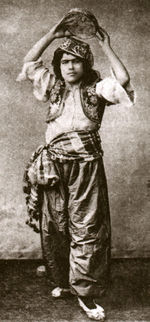 Kocek with tambourine
Kocek with tambourinec. 19th-century Turkish boy dancer.
The tambourine is a musical instrument of the percussion family consisting of a single drumhead mounted on a ring with small metal jingles. It is held in the hand and can be played in numerous ways, from stroking or shaking the jingles to striking it sharply with hand or stick or using the tambourine to strike the leg or hip. It is found in many forms of music, classical music, Roma music, Persian music, gospel music, pop music and rock and roll. The word tambourine finds its origins in the Middle Persian word tambūr "lute, drum" (via the Middle French tambour).
Contents |
Riqq
Small, circular frame drum with jingles, of the Arab countries. It is used in Egypt, Iraq, Lebanon, Palestine, Sudan and Syria; in Libya, where it is rare, it is called mriqq. It is between 20 and 25 cm in diameter and is now effectively a manís instrument. Descended from the duff (see Daff), like the Tar, the riqq acquired its name in the 19th century so that it could be differentiated.
Essentially an instrument of music for the connoisseur, the riqq, which is also called daff al-zinjari in Iraq, is played in takht ensembles (Egypt, Syria) or shalghi ensembles (Iraq) where it has a particularly clearcut role, going beyond the simple rhythmic requirements of the duff, tar or mazhar, and exploding in a burst of imaginative freedom to colour the orchestra with gleaming sounds: this is quite unlike the role of the duff. In Sudan, where it seems to have been introduced recently, the riqq is also related to worship, as in upper Egypt.
The instrument is carefully made. Its delicate frame is covered on both the inner and outer sides with inlay (mother-of-pearl, ivory or precious wood, like apricot or lemon) and has ten pairs of small cymbals (about 4 cm in diameter), grouped in two slits, each having five pairs. The skin of a fish is glued on and tightened over the frame, which is about 6 cm deep. In Egypt the riqq is usually 20 cm wide; in Iraq it is slightly larger.
Traditionally, frame drums have been used to support the voices of singers, who manipulate them themselves; but the player of the riqq, like that of the doira of Uzbekistan, plays without singing. While the duff and the mazhar are held relatively still, at chest or face height, with the player seated, the riqq, because of the use of different tone-colours, may be violently shaken above the head, then roughly lowered to the knee, and played vertically as well as horizontally. The player alternates between striking the membrane and shaking the jingles, and his need for freedom of movement necessitates that he stand up. Students of the instrument are required to master the technical problems imposed by the timbre of the membrane and the jingles, both separately and in combination; aside from developing a virtuoso technique they also need to learn the many rhythmic cycles and the techniques of modifying them through creative invention.
Buben

Buben (Бубен in Russian and Ukrainian, бу̑бањ in Serbian, bǫ̑bǝn in Slovenian, buben in Czech, bęben in Polish) is a musical instrument of the percussion family similar to a tambourine. A buben consists of a wooden or metal hoop with a tight membrane stretched over one of its sides (some bubens have no membrane at all). Certain kinds of bubens are equipped with clanking metal rings, plates, cymbals, or little bells. It is held in the hand and can be played in numerous ways, from stroking or shaking the jingles to striking it sharply with hand. It is used for rhythmical accompaniment during dances, soloist or choral singing. Buben is often used by some folk and professional bands, as well as orchestras.
The name came from Greek language βόμβος (low and hollow sound) and βομβύλη (a breed of bees) and related to Indo-Aryan bambharas (bee) and English bee.
Buben is known to have existed in many countries since time immemorial, especially in the East. There are many kinds of bubens, including def, dyaf, or gabal (Azerbaijan), daf or khaval (Armenia), daira (Georgia), doira (Uzbekistan and Tajikistan), daire or def (Iran), bendeir (Arab countries), pandero (Spain). In Kievan Rus, drums and military timpani were referred to as buben.
External links
- Traditional tambourines from Carnival of Binche (in French)
- Christina Campo-Abdoun & Seifed-Din Abdoun Center For Arabic Culture (CAC)
Categories: Idiophones | Membranophones | Folk instruments | Drum kit components




 216.73.216.190
216.73.216.190 User Stats:
User Stats:
 Today: 0
Today: 0 Yesterday: 0
Yesterday: 0 This Month: 0
This Month: 0 This Year: 0
This Year: 0 Total Users: 117
Total Users: 117 New Members:
New Members:
 216.73.xxx.xxx
216.73.xxx.xxx
 Server Time:
Server Time: